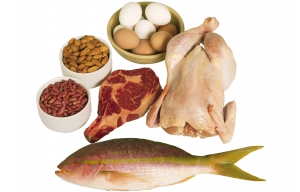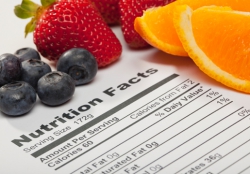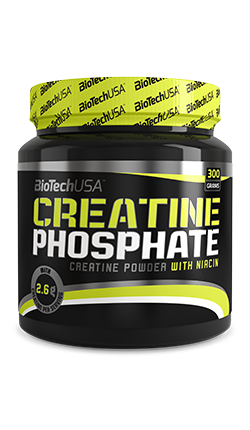
Bulking recommendations

The basics
Your nutritional needs will increase when you start working out. During exercise your muscles are injured, your nutrient storage is depleted, your joints are under a bigger load. Your body desperately seeks to take in as many nutrients as possible and even more when the next stressful event comes so it would be able to tackle the situation much more easily (supercompensation).
To put it simple: if you want to grow muscles, you must give a bigger push to your body, need to eat more than average and this way your body can handle the excess muscle strain.
Workout
It’s a good plan to lift selected weights during bulking, but only in a limited number of repetitions.
It is ideal to do 6 to 8 repetitions during a set. It enables you to work with bigger weights without the risk of getting injured. You may want to do exercises that will get you pumped and keep a high number of repetitions, but the first 2 exercises should be basic ones (bench press, squats, dead lifts, shoulder press, arm flexing, military press – depending on your daily schedule).
These basic exercises will work the whole of the given muscle, ancillary muscles included! This way you can exploit every second of your training so that your bulking process is enhanced! It is important to carry out the repetitions in the whole range, that you wouldn’t be doing half presses, half squats or you wouldn’t pull all over the place because then you can get more easily injured!
Nutrition
Training and exercise is only one part of a successful bulking programme. You may work very hard in the gym, but there is no use in adding weights if your body doesn’t get the energy and the protein it requires.
In bulking there is a short path and the right path – both have their advantages and disadvantages.
The short path
 I often hear that during bulking people calculate with 2 gr of protein and 4–5 gr of carbohydrates for their weight (in kg), but where does it come from? Let’s see… from pizza with chips, and a few scoops of ice cream to round it off at the end! Some people munch on a large portion of Oreos with your protein shake after workout, chip on some doughnut during the day and prior to training they gulp in breaded and deed fried chicken breast with spaghetti.
I often hear that during bulking people calculate with 2 gr of protein and 4–5 gr of carbohydrates for their weight (in kg), but where does it come from? Let’s see… from pizza with chips, and a few scoops of ice cream to round it off at the end! Some people munch on a large portion of Oreos with your protein shake after workout, chip on some doughnut during the day and prior to training they gulp in breaded and deed fried chicken breast with spaghetti.
If your aim is to get as far from zero on the scale as possible, then feel free to follow their example. Your T-shirt is going to get tight very soon! However, it might not only be at the right spots…
If you opt for such a diet, you are definitely taking in more calories than you should! It will result in you having loose capillaries, a rounded face, a beer belly and you become large. Large, strong, without the shapes you could take delight in.
There are of course people who can eat whatever they want and as much as they want, and they won’t be getting any fatter. They are called the lucky ones. I’m not this type, therefore I will not choose this option, no matter how much I would like to.
The right way – this is what we recommend!
You should measure your body fat percentage, then calculate the necessary protein/carbohydrate/fat intake for a fat free body.
2 grams per kilogram (in body weight) is an ideal and easily consumable protein quantity, but it might be more problematic to take in 4 gr of carbohydrate. You may want to start from a lower level and increase the dose gradually. If you see that you are growing faster than you should, you may want to reduce the dose. 3 gr might be sufficient to assist your development.
But how?
You’d better become good buddies with the kitchen scale when preparing your meals. Otherwise you will have no idea how much rice or meat to use.
For meals that require oil, start using coconut oil. It is not more expensive; your meals won’t get burned nor will they smell/taste coconut and you can eliminate the bad fats altogether!
Green spices are OK, but don’t use any spice with artificial flavourings or flavour enhancer.
Contact grill or baking bags might be new to some of you, but you should try them as they save you time and enable you to prepare more varied food!
When you calculate how much protein and carbs you need, always do so with the raw ingredients, because meat for example loses a portion of its mass, while rice, pasta and (cooked) potato become heavier during cooking.
What should you cook?
 Protein can be found in large quantities in meat, egg, cheese and dairy products.
Protein can be found in large quantities in meat, egg, cheese and dairy products.
- A classic bodybuilder’s meal is chicken breast, which might be too dry or tasteless for many (Have you tried spices or the baking bag?). Of course, chicken thigh is also good (unless you are on a diet because of a competition). Turkey breast, turkey thigh, pure pork meat (loin, shoulder, thigh, tenderloin) could be a good replacement for poultry.
- Beef is also a great choice, but you should learn how to prepare it correctly.
- Sea fish and other saltwater ingredients are recommended due to their high Omega 3 fatty acid content.
- Freshwater fish could be another option, but be very careful with the fishbone!
The meat industry offers a wide range of products, which we will now simple refer to as “cold cuts”.
You shouldn’t consume cold cuts as they contain a huge amount of preservatives and additives useless for your body, and they are not good value for money, either.
Home-made smoked meats are some sort of delicacy that I wouldn’t consider as a basic source to replenish your daily protein need, it’s something that you eat once the regular portion has been taken care of.
Eggs and cottage cheese are among the top 10 protein sources. If you are bored with plain cottage cheese or can’t even look at scrambled eggs anymore, there are many recipes to make your diet more variable.
Fat content must also be taken into consideration. You should be fine unless you eat 50–60 eggs per day or eat the farm produced cottage cheese with the highest fat content.
Vegetables also contain protein, especially pulses. But vegetarians or vegans should not calculate it into their protein intake.
There are many carbohydrate sources, but if you want to eat healthily the options are dramatically reduced.
Avoid simple carbohydrates (sugars), and you need to know when and how much you can take in so your insulin level wouldn’t be volatile. Complex carbs cause your body to work harder and they can also be broken down so your body won’t have to produce so much insulin.
You can choose any type of rice (white, brown, jasmine, basmati, puffed rice or rice noodles). When you get bored with rice, sweet potato is another great choice. Bodybuilders also prefer oatmeal, millet, buckwheat, bulgur or couscous.
Pastas can be trickier, but you can opt for wholemeal or durum pasta.
Peas, corn, lentils and beans are also recommended, but only with moderation – if you have a sensitive stomach.
Bakery products (bread, rolls, croissant and freshly baked pastries) should be avoided, since in most cases you can’t trace back neither their ingredients nor their carbohydrate content.
Question: How do you know the nutrient content of a given food?
Answer: look for the nutritional data on the packaging!
 Nowadays you will find a black and white table on almost all packaged food that describes in detail the protein, carbohydrate, fat, salt and other ingredients that the given product contains. If you don’t find such a label on the product, put it back on the shelf.
Nowadays you will find a black and white table on almost all packaged food that describes in detail the protein, carbohydrate, fat, salt and other ingredients that the given product contains. If you don’t find such a label on the product, put it back on the shelf.
You don’t have to be so strict when it comes to vegetables. There are many detailed charts available on the internet that can provide you with information of the veggies you might want to eat. Such a chart will make it easy to calculate how much you can eat of each ingredient.
And… keep in mind that carrot is not only for bunnies. Eat a lot of vegetables!
A diet rich in fibre will help the efficient functioning of your body, the cleansing of your intestines and a large bowl of broccoli will do as a side dish for dinner, instead of rice or potato. You should leave behind the typical Hungarian paprika–tomato–cucumber combination and try new veggies, as well.
Question: I did my calculation, but it is impossible to eat this much! What should I do?
Answer: Seek help from food supplements.
But remember, food supplements are there to supplement, but never to replace! You should enjoy proper food, don’t sip on protein shake all day long.
Let me talk about the most important food supplements that can help your bulking process.
 Vitamins – they help the functioning of the immune system, make you energetic and assist the nutrients to be built-in more easily.
Vitamins – they help the functioning of the immune system, make you energetic and assist the nutrients to be built-in more easily.
Protein shakes – they have a high protein content, contain few calories and are an ideal choice for breakfast, for example with oatmeal.
Bulking shake – It is ideal after training to replenish your depleted glycogen reserves due to its high carbohydrate content. It also contains protein as well, so your muscles don’t start breaking down until your next meal.
BCAA-Glutamine – They are isolated amino acids (BCAA means Branched Chain Amino Acids – it consist of leucine, isoleucine and valine) help the anabolic – muscle-building – processes, and they prevent the catabolic – that is the breaking down – process. Protein shakes contain these amino acids, but if you take an extra dose your bulking will be even more effective! You can take it anytime – during the day, before, during and even after workout.
Creatine – the all-time favourite of everyone. It is an amino acid that enhances your strength level. It is also found in beef meet. You should really experiment to find the best source of creatine for you. It can be purchased in simple powder form or in capsules, but there are types that contain a variety of creatines as well.
I hope that you found this article useful and I wish you all the best with your bulking plans!
Fegyi